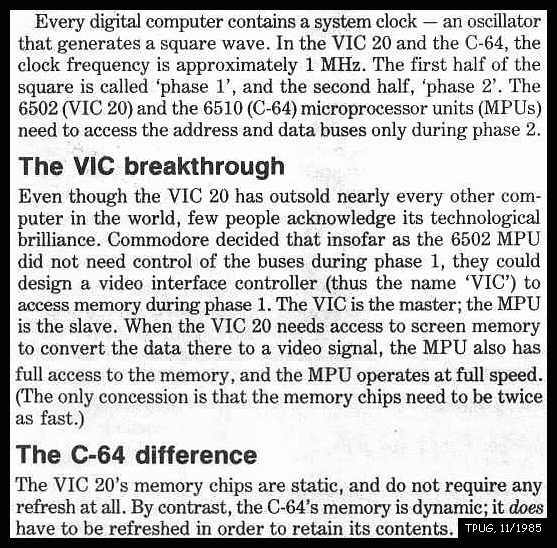 Yes the VIC-20. That was a strange project. It was a G-job really. G-job
means fun projects that we (engineers at Commodore) did on our own time.
Yes the VIC-20. That was a strange project. It was a G-job really. G-job
means fun projects that we (engineers at Commodore) did on our own time. Bill
Seiler Remembers the VIC-20
- from an interview conducted by Rick Melick on
November 5, 1996
 Yes the VIC-20. That was a strange project. It was a G-job really. G-job
means fun projects that we (engineers at Commodore) did on our own time.
Yes the VIC-20. That was a strange project. It was a G-job really. G-job
means fun projects that we (engineers at Commodore) did on our own time.
Just before the VIC-20 was born I was working at Commodore on the TOI project. TOI was to be an Apple II competitor. You know 40 columns color graphics, 6502 and all that stuff. Al Charpenter was helping me with a new chip to do the video in the TOI design. I think Al grew the TOI into the Commodore 64 chip later on.
The VIC chip was a finished working graphics chip designed by Al and friends at MOS Technology. The VIC chip was aimed at the video game market which at the time was dominated by ATARI 2600 game machines. At that time the Sinclair Z80 computer was selling like crazy for less than $100. I had some of these VIC chips for some time and decided we could do a low cost computer based on it.
I replaced the video section of the standard PET computer with the VIC graphics chip. I sawed the PET mother board in half, removing the video section and wired in the VIC chip. with the help of John Feagans we patched the system roms for the PET to used the VIC for video.
The first real problem was how to do color. The PET already had a simple way to do character graphics, so we just extended the idea to add color characters to it.
A few months before, I had pulled one of Commodores old
printing calculators from the trash. I removed the calculator guts and modified the case
to take the original small PET keyboard and then modified VIC/PET mother board to fit
inside. We had a rough working prototype at this time. This was not an official project
yet. We were just doing it for fun. Unknown to us at the time the guys at MOS Technology
had been working on a prototype of there own. 
Their machine was also VIC/6502 based but had no operating system or BASIC. It was aimed more for the game market then the personal computer market. It had game cartridge slots, the small PET keyboard, and a real case.
The big CES show was coming up soon and suddenly there was a big push to get a prototype there. It was a bit of a horse race within Commodore to get their prototype to CES first. The PET group felt the machine should be at the minimum a computer. It should have a language (BASlC) to write programs in, and a way to save and load programs (cassette tape).
Chuck Peddle modified his cassette tape read/write routines to operate at the new clock speed for this hybrid VIC/PET. We cleaned up the calculator case and added an external PET cassette drive. Lenard Tramiel and I modified some PET games to have color and use the smaller VIC screen size. We shipped the prototype off to CES and it came back a big hit.
Suddenly the VIC-20 was a big project at Commodore. Chuck Peddle gathered all the PET engineers together to do the design for the VIC-20 in about one month. We had wall to wall meetings to finish this design. I remember Chuck even had Bob Metcalfe come and give us a lecture on his new idea, ethernet!
We adapted the PET IEEE-488 parallel bus to the serial bus used in the VIC-20. I remember the VIC-20 had a convoluted ram address space. We were trying to make some price point so we could only put in 5K of ram. Also due to the limits in the VIC graphic chip (16K max) I had a 1K block of memory low, a 4K hole of nothing, then 4K more ram. Our prototype was shipped off to Japan where it was packaged with the larger PET keyboard you see in the final VIC-20's.
That it for now!
Bill Seiler